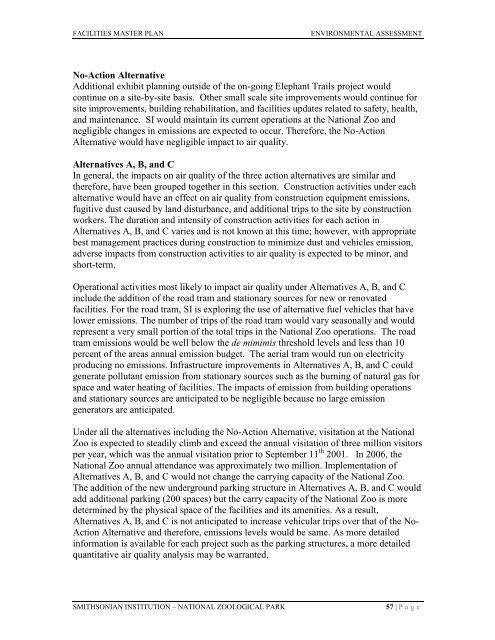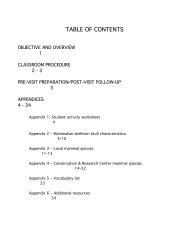facilities renewal master plan - National Zoo - Smithsonian Institution
facilities renewal master plan - National Zoo - Smithsonian Institution
facilities renewal master plan - National Zoo - Smithsonian Institution
You also want an ePaper? Increase the reach of your titles
YUMPU automatically turns print PDFs into web optimized ePapers that Google loves.
FACILITIES MASTER PLAN ENVIRONMENTAL ASSESSMENT<br />
No-Action Alternative<br />
Additional exhibit <strong>plan</strong>ning outside of the on-going Elephant Trails project would<br />
continue on a site-by-site basis. Other small scale site improvements would continue for<br />
site improvements, building rehabilitation, and <strong>facilities</strong> updates related to safety, health,<br />
and maintenance. SI would maintain its current operations at the <strong>National</strong> <strong>Zoo</strong> and<br />
negligible changes in emissions are expected to occur. Therefore, the No-Action<br />
Alternative would have negligible impact to air quality.<br />
Alternatives A, B, and C<br />
In general, the impacts on air quality of the three action alternatives are similar and<br />
therefore, have been grouped together in this section. Construction activities under each<br />
alternative would have an effect on air quality from construction equipment emissions,<br />
fugitive dust caused by land disturbance, and additional trips to the site by construction<br />
workers. The duration and intensity of construction activities for each action in<br />
Alternatives A, B, and C varies and is not known at this time; however, with appropriate<br />
best management practices during construction to minimize dust and vehicles emission,<br />
adverse impacts from construction activities to air quality is expected to be minor, and<br />
short-term.<br />
Operational activities most likely to impact air quality under Alternatives A, B, and C<br />
include the addition of the road tram and stationary sources for new or renovated<br />
<strong>facilities</strong>. For the road tram, SI is exploring the use of alternative fuel vehicles that have<br />
lower emissions. The number of trips of the road tram would vary seasonally and would<br />
represent a very small portion of the total trips in the <strong>National</strong> <strong>Zoo</strong> operations. The road<br />
tram emissions would be well below the de mimimis threshold levels and less than 10<br />
percent of the areas annual emission budget. The aerial tram would run on electricity<br />
producing no emissions. Infrastructure improvements in Alternatives A, B, and C could<br />
generate pollutant emission from stationary sources such as the burning of natural gas for<br />
space and water heating of <strong>facilities</strong>. The impacts of emission from building operations<br />
and stationary sources are anticipated to be negligible because no large emission<br />
generators are anticipated.<br />
Under all the alternatives including the No-Action Alternative, visitation at the <strong>National</strong><br />
<strong>Zoo</strong> is expected to steadily climb and exceed the annual visitation of three million visitors<br />
per year, which was the annual visitation prior to September 11 th 2001. In 2006, the<br />
<strong>National</strong> <strong>Zoo</strong> annual attendance was approximately two million. Implementation of<br />
Alternatives A, B, and C would not change the carrying capacity of the <strong>National</strong> <strong>Zoo</strong>.<br />
The addition of the new underground parking structure in Alternatives A, B, and C would<br />
add additional parking (200 spaces) but the carry capacity of the <strong>National</strong> <strong>Zoo</strong> is more<br />
determined by the physical space of the <strong>facilities</strong> and its amenities. As a result,<br />
Alternatives A, B, and C is not anticipated to increase vehicular trips over that of the No-<br />
Action Alternative and therefore, emissions levels would be same. As more detailed<br />
information is available for each project such as the parking structures, a more detailed<br />
quantitative air quality analysis may be warranted.<br />
SMITHSONIAN INSTITUTION – NATIONAL ZOOLOGICAL PARK 57 | P a g e

















